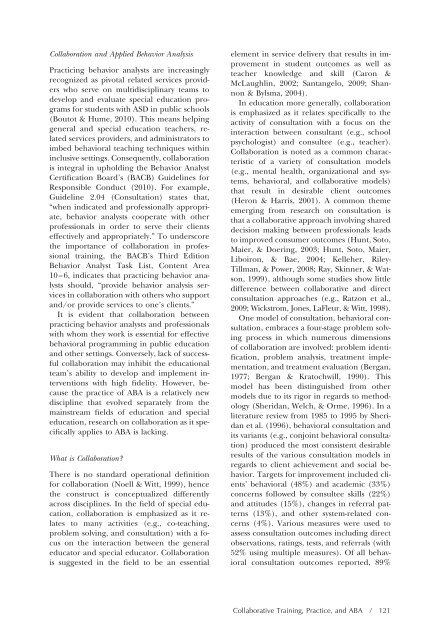etadd_48(1) - Division on Autism and Developmental Disabilities
etadd_48(1) - Division on Autism and Developmental Disabilities
etadd_48(1) - Division on Autism and Developmental Disabilities
Create successful ePaper yourself
Turn your PDF publications into a flip-book with our unique Google optimized e-Paper software.
Collaborati<strong>on</strong> <strong>and</strong> Applied Behavior Analysis<br />
Practicing behavior analysts are increasingly<br />
recognized as pivotal related services providers<br />
who serve <strong>on</strong> multidisciplinary teams to<br />
develop <strong>and</strong> evaluate special educati<strong>on</strong> programs<br />
for students with ASD in public schools<br />
(Boutot & Hume, 2010). This means helping<br />
general <strong>and</strong> special educati<strong>on</strong> teachers, related<br />
services providers, <strong>and</strong> administrators to<br />
imbed behavioral teaching techniques within<br />
inclusive settings. C<strong>on</strong>sequently, collaborati<strong>on</strong><br />
is integral in upholding the Behavior Analyst<br />
Certificati<strong>on</strong> Board’s (BACB) Guidelines for<br />
Resp<strong>on</strong>sible C<strong>on</strong>duct (2010). For example,<br />
Guideline 2.04 (C<strong>on</strong>sultati<strong>on</strong>) states that,<br />
“when indicated <strong>and</strong> professi<strong>on</strong>ally appropriate,<br />
behavior analysts cooperate with other<br />
professi<strong>on</strong>als in order to serve their clients<br />
effectively <strong>and</strong> appropriately.” To underscore<br />
the importance of collaborati<strong>on</strong> in professi<strong>on</strong>al<br />
training, the BACB’s Third Editi<strong>on</strong><br />
Behavior Analyst Task List, C<strong>on</strong>tent Area<br />
10–6, indicates that practicing behavior analysts<br />
should, “provide behavior analysis services<br />
in collaborati<strong>on</strong> with others who support<br />
<strong>and</strong>/or provide services to <strong>on</strong>e’s clients.”<br />
It is evident that collaborati<strong>on</strong> between<br />
practicing behavior analysts <strong>and</strong> professi<strong>on</strong>als<br />
with whom they work is essential for effective<br />
behavioral programming in public educati<strong>on</strong><br />
<strong>and</strong> other settings. C<strong>on</strong>versely, lack of successful<br />
collaborati<strong>on</strong> may inhibit the educati<strong>on</strong>al<br />
team’s ability to develop <strong>and</strong> implement interventi<strong>on</strong>s<br />
with high fidelity. However, because<br />
the practice of ABA is a relatively new<br />
discipline that evolved separately from the<br />
mainstream fields of educati<strong>on</strong> <strong>and</strong> special<br />
educati<strong>on</strong>, research <strong>on</strong> collaborati<strong>on</strong> as it specifically<br />
applies to ABA is lacking.<br />
What is Collaborati<strong>on</strong>?<br />
There is no st<strong>and</strong>ard operati<strong>on</strong>al definiti<strong>on</strong><br />
for collaborati<strong>on</strong> (Noell & Witt, 1999), hence<br />
the c<strong>on</strong>struct is c<strong>on</strong>ceptualized differently<br />
across disciplines. In the field of special educati<strong>on</strong>,<br />
collaborati<strong>on</strong> is emphasized as it relates<br />
to many activities (e.g., co-teaching,<br />
problem solving, <strong>and</strong> c<strong>on</strong>sultati<strong>on</strong>) with a focus<br />
<strong>on</strong> the interacti<strong>on</strong> between the general<br />
educator <strong>and</strong> special educator. Collaborati<strong>on</strong><br />
is suggested in the field to be an essential<br />
element in service delivery that results in improvement<br />
in student outcomes as well as<br />
teacher knowledge <strong>and</strong> skill (Car<strong>on</strong> &<br />
McLaughlin, 2002; Santangelo, 2009; Shann<strong>on</strong><br />
& Bylsma, 2004).<br />
In educati<strong>on</strong> more generally, collaborati<strong>on</strong><br />
is emphasized as it relates specifically to the<br />
activity of c<strong>on</strong>sultati<strong>on</strong> with a focus <strong>on</strong> the<br />
interacti<strong>on</strong> between c<strong>on</strong>sultant (e.g., school<br />
psychologist) <strong>and</strong> c<strong>on</strong>sultee (e.g., teacher).<br />
Collaborati<strong>on</strong> is noted as a comm<strong>on</strong> characteristic<br />
of a variety of c<strong>on</strong>sultati<strong>on</strong> models<br />
(e.g., mental health, organizati<strong>on</strong>al <strong>and</strong> systems,<br />
behavioral, <strong>and</strong> collaborative models)<br />
that result in desirable client outcomes<br />
(Her<strong>on</strong> & Harris, 2001). A comm<strong>on</strong> theme<br />
emerging from research <strong>on</strong> c<strong>on</strong>sultati<strong>on</strong> is<br />
that a collaborative approach involving shared<br />
decisi<strong>on</strong> making between professi<strong>on</strong>als leads<br />
to improved c<strong>on</strong>sumer outcomes (Hunt, Soto,<br />
Maier, & Doering, 2003; Hunt, Soto, Maier,<br />
Liboir<strong>on</strong>, & Bae, 2004; Kelleher, Riley-<br />
Tillman, & Power, 2008; Ray, Skinner, & Wats<strong>on</strong>,<br />
1999), although some studies show little<br />
difference between collaborative <strong>and</strong> direct<br />
c<strong>on</strong>sultati<strong>on</strong> approaches (e.g., Ratz<strong>on</strong> et al.,<br />
2009; Wickstrom, J<strong>on</strong>es, LaFleur, & Witt, 1998).<br />
One model of c<strong>on</strong>sultati<strong>on</strong>, behavioral c<strong>on</strong>sultati<strong>on</strong>,<br />
embraces a four-stage problem solving<br />
process in which numerous dimensi<strong>on</strong>s<br />
of collaborati<strong>on</strong> are involved: problem identificati<strong>on</strong>,<br />
problem analysis, treatment implementati<strong>on</strong>,<br />
<strong>and</strong> treatment evaluati<strong>on</strong> (Bergan,<br />
1977; Bergan & Kratochwill, 1990). This<br />
model has been distinguished from other<br />
models due to its rigor in regards to methodology<br />
(Sheridan, Welch, & Orme, 1996). In a<br />
literature review from 1985 to 1995 by Sheridan<br />
et al. (1996), behavioral c<strong>on</strong>sultati<strong>on</strong> <strong>and</strong><br />
its variants (e.g., c<strong>on</strong>joint behavioral c<strong>on</strong>sultati<strong>on</strong>)<br />
produced the most c<strong>on</strong>sistent desirable<br />
results of the various c<strong>on</strong>sultati<strong>on</strong> models in<br />
regards to client achievement <strong>and</strong> social behavior.<br />
Targets for improvement included clients’<br />
behavioral (<str<strong>on</strong>g>48</str<strong>on</strong>g>%) <strong>and</strong> academic (33%)<br />
c<strong>on</strong>cerns followed by c<strong>on</strong>sultee skills (22%)<br />
<strong>and</strong> attitudes (15%), changes in referral patterns<br />
(13%), <strong>and</strong> other system-related c<strong>on</strong>cerns<br />
(4%). Various measures were used to<br />
assess c<strong>on</strong>sultati<strong>on</strong> outcomes including direct<br />
observati<strong>on</strong>s, ratings, tests, <strong>and</strong> referrals (with<br />
52% using multiple measures). Of all behavioral<br />
c<strong>on</strong>sultati<strong>on</strong> outcomes reported, 89%<br />
Collaborative Training, Practice, <strong>and</strong> ABA / 121
















